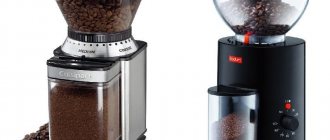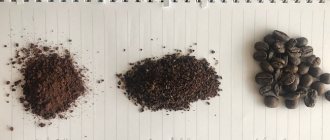Types of grinding coffee beans
The taste and aroma of the finished coffee largely depends on proper grinding.
The roasted beans are ground into particles of a size suitable for the specific method of preparing the drink. At home, achieving perfect coffee grinding is more difficult than using special equipment or a coffee grinder, but the drink does not lose its taste characteristics and gives the aroma of real coffee. Types of grinding:
- Large/rough. The size of the ground particles reaches 1 mm. Suitable for preparation in a French press, coffee pot, vacuum coffee maker, since large particles reveal the aroma well and do not end up in the cup. To obtain large fractions without a coffee grinder, use a food processor or blender.
- Average. A simple option for grinding coffee beans without a coffee grinder to a medium grind is manual application with a hammer, mortar, or knife. Medium fractions reveal flavor well in drip coffee makers.
- Thin. Small fractions of coffee beans are used for preparation in a Turk; espresso is brewed from them, aromatic drinks are brewed in geyser coffee makers and coffee machines. You can grind the beans until finely ground using a rolling pin and mortar and pestle, without using a coffee grinder.
- Extra-thin. Grinding the beans to a powder is suitable for making delicious Greek or Turkish coffee. Coffee grounds give the drink a special taste; you can use a mortar and pestle to grind it.
True gourmets will not refuse a cup of aromatic drink, even when there is no coffee grinder at hand. The fineness of the grind directly affects the strength and taste. For example, coffee powder produces rich, thick espresso. The beans, ground to a medium fraction, are suitable for making various drinks, including lattes.
Why make homemade flour?
Here are some good reasons to try homemade flour:
- Freshness, which can be attributed to both taste and smell, is the first reason for preparing flour. The time after the grains become flour is the moment of maximum flavor. Later, oxygen begins to work to remove odor and decompose fatty acids. It has been scientifically proven that, due to the above facts, fresh flour should be stored in the refrigerator for no more than three days. In addition, some types of fresh flour, such as buckwheat, corn, oatmeal and rye, are subject to a rapid decrease in nutrients than wheat. An analogy can be drawn with coffee beans when they are just ground. Many coffee fans brew it immediately after grinding the beans; the taste and aroma at first are much brighter than after it sits for two weeks.
- Diversity. Often, for example, in supermarkets or specialized markets you can see various varieties of all kinds of cereal plants. This may not give rise to the idea of trying to make flour from them and prepare original baked goods.
- Control. Not only is most modern flour inferior in value to its predecessor, but it can also vary in quality depending on the manufacturer. By milling your own flour, you can control the protein content in it by choosing the appropriate type of grain. You can mix exactly the flour mixture you need without having to buy several different bags of flour. With a good mill, you can turn any grain into fine, medium or coarse flour to suit your needs.
- Price. Whole grains are cheaper than the flour that is made from them. Depending on the price you pay for unmilled grain, you can easily make homemade bread cheaper than store-bought bread. However, don't expect to be able to offset the purchase of a mill by not having to pay for ready-made flour unless you make it yourself regularly and in large quantities. quantities.
- Convenience. We always look at the expiration date of certain products we buy. However, we believe that flour can be stored for a very long time without loss of quality. It's not like that at all. After long-term storage, it will definitely lose in the amount of nutrients compared to freshly ground flour. While whole grains can be stored for many years and retain all the important microelements.
Using various kitchen appliances
There are enough utensils in the kitchen that are suitable for grinding coffee beans into fractions of the desired size. If you don't have a coffee grinder, you can use:
- Food processor.
- Blender.
- Meat grinder.
The grinding process takes a little time, the coffee is crushed into uneven large fractions. When using a meat grinder, both manual and electric models are suitable to grind coffee beans quickly and accurately.
Important! When grinding with a food processor, the grains are ground in short pulses of five seconds, after pouring the grains into a container. After grinding, the processor must be immediately disassembled and washed so that it does not retain the coffee aroma.
Blender
A blender is best for grinding fairly hard beans, especially if you need to get coarse coffee. To prevent the unit from overheating, the device is started in short pulses. How to grind coffee using a blender if you don’t have a coffee grinder:
- pour 100 grams of grains into a container;
- set the grinding option on the blender;
- grind at intervals of a couple of seconds;
- add more grain if necessary;
- repeat the grinding process.
When enough coarse coffee has been prepared, the product is poured out of the container, the blender is disassembled and immediately washed thoroughly. This helps eliminate the aroma of the roasted beans.
Important. When using an immersion blender for grinding, the grains are placed in a narrow container, and the hole is covered with your hand so that the grains do not “jump out”. Grind the product pulsed at intervals of 10 seconds.
Meat grinder
There is an electric or mechanical meat grinder in every home. It can be easily adapted for grinding coffee at home. The meat grinder needs to be disassembled and washed well so that the coffee beans do not absorb the odors of other products. If the set includes a special knife for grinding spices, you will get medium grinding fractions.
The required amount of grains is poured into the hole of the meat grinder and ground until uniform fractions are formed. Each repeated grinding makes the particles even smaller. The finished product is suitable for preparing the drink in French presses, coffee makers, Turks, and teapots.
Manual grinding
It happens that there is no suitable kitchen equipment to grind coffee without a coffee grinder. Proven methods of manual grinding using kitchen utensils and ordinary household appliances come to the rescue. Such grinding does not take much time and effort - to grind coffee beans without a coffee grinder, you need to spend a few minutes, and you can enjoy the taste of your favorite drink.
Mechanical mill
Many housewives have such a simple device in their kitchen as a spice grinder. It can easily grind coffee beans to a medium grind fraction. Fine powder will not work, nor will large portions of coffee, but you can prepare the beans immediately before brewing the drink.
The grains are poured into the mill and the millstones are turned using a handle or a lid - depending on the design. From the first grinding, large fractions are obtained, after repeated grinding - raw materials that are suitable for brewing coffee, for example, in a Turk.
Hammer
An alternative method for hand grinding is to crush the beans with a hammer. The more intense the grinding, the finer the fraction of the prepared product. A chopping hammer, regular hammer or mallet is suitable. How to grind coffee:
- The grains are poured onto parchment paper or into a bag.
- The table is covered with a towel and wrapped beans are placed.
- The grains are “crushed” with uniform blows of the hammer.
The result is finished raw material of large or medium fraction. Suitable for brewing or steaming. To obtain a fine powder, repeat the manipulations several times. The grains should be laid out in a thin, even layer - this makes it easier to chop the beans.
In a mortar
A simple method of grinding is to use a mortar and pestle. The old-fashioned method requires some effort, since the beans will have to be crushed into fine crumbs. But the time spent is worth it - the grains can be crushed to any fraction.
Pour a small portion of beans into a mortar. Using a pestle, the coffee is first crushed, then crushed to the desired fraction, and vigorously crushed in a mortar. You don't need to add a lot of beans to get a smooth grind.
Rolling pin
If it is not possible to use a coffee grinder to grind coffee, a regular rolling pin will do. With its help, raw materials of medium and fine grinding are obtained. You don't need anything other than a rolling pin and a freezer bag. How to grind grains:
- pour a small amount of beans into the bag;
- place on a flat surface - table, board;
- spread the coffee beans in an even layer;
- press down with a rolling pin to break up hard beans;
- crush the raw materials to the desired grinding fraction.
On a note. You can use a large carving knife instead of a rolling pin. The grains are placed on a hard surface, pressed flat with a knife and crushed into large crumbs.
Do you need to sift?
A must, just like store-bought. But it is advisable to do this several times. Place what does not pass the sifting into a separate plate; it can be used to top your baked goods or added directly to the dough for a thicker consistency. By the way, sifting is necessary not only to get rid of large pieces of cereal or beans, but also to fill the flour with air. Such pastries will be airy and, of course, delicious.
Found a violation? Report content
What to remember when using household appliances for purposes other than their intended purpose
Each kitchen device has a specific purpose - grinding, cutting, chopping. You can grind coffee beans without a coffee grinder using electric meat grinders, blenders, and food processors. But several important points cannot be ignored:
- Using household appliances for other purposes shortens the service life of the appliances.
- Parts of devices (knives, cutters) may become dull from exposure to hard grains.
- Equipment should be thoroughly washed before and after processing coffee beans to prevent the coffee from absorbing the flavor of the food.
If the equipment is used for a long time for other purposes, its knives may become deformed. As a one-time option, such grinding of grains is suitable, but you should not get carried away so as not to spoil expensive household appliances.
Types of grain grinding machines
Based on the principle of operation, machines for the grain grinding process can be divided into several types. These include:
- Hammer machine - in this design, the elements for grinding must be mounted on a rotor, which will rotate in the receiving hopper itself.
- Impact crusher - the working chambers in units of this type are made of durable metal, which gives the machine the greatest strength and reliability. The parts for the grinding process hit the walls of the hopper, at the same time crushing the grain. With all this, the crushing parts will continue to hit the walls until the grain is completely transformed into a mixture of the smallest components.
- Disc machine - in this design there are crushing knives that will be attached to the shaft using specialized disks.
- Vadets crusher - it can perform both crushing and grinding of grain. The main element in this design will be corrugated rollers. They will only process wet material efficiently. Dry grain should be pre-moistened in water.
Tips for storing ground coffee
According to true gourmets, the most delicious and aromatic coffee comes from beans that are ground before preparing the drink. If you have a supply of ground coffee, it must be stored correctly so that the finished raw material does not lose its valuable properties, delicate aroma, and taste characteristics. Conditions for storing ground beans:
- sealed packaging;
- cool dark place;
- lack of heat, humidity;
- away from sunlight, light.
In ground form, coffee retains its properties for a week if stored in a tightly closed container or factory packaging. Once opened, raw materials lose their value within a day. The powder quickly absorbs moisture, which destroys the taste and aroma of the beans. It is best to store ground coffee in an airtight container in a kitchen cabinet with opaque doors, but not on the top shelf.
Subtle aroma, invigorating taste, rich strength - this is coffee, the favorite drink of millions of people. Different varieties, manufacturers, and grinding fractions create a wide choice for preparing the drink. The most delicious coffee is made from freshly ground beans. And if you don’t have a coffee grinder at hand, you can use kitchen appliances and accessories. Grinding beans with a blender, meat grinder, rolling pin and other methods does not in any way affect the taste characteristics of the coffee and the drink does not lose its strength and aroma.










